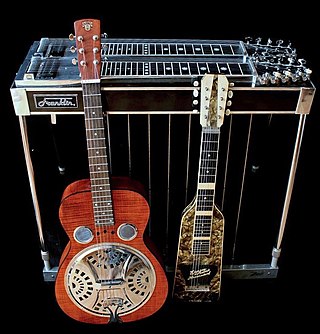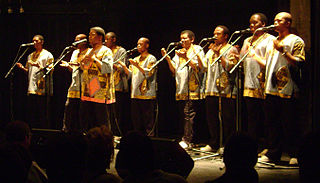
In music performances, rhythm guitar is a technique and role that performs a combination of two functions: to provide all or part of the rhythmic pulse in conjunction with other instruments from the rhythm section ; and to provide all or part of the harmony, i.e. the chords from a song's chord progression, where a chord is a group of notes played together. Therefore, the basic technique of rhythm guitar is to hold down a series of chords with the fretting hand while strumming or fingerpicking rhythmically with the other hand. More developed rhythm techniques include arpeggios, damping, riffs, chord solos, and complex strums.

A steel guitar is any guitar played while moving a steel bar or similar hard object against plucked strings. The bar itself is called a "steel" and is the source of the name "steel guitar". The instrument differs from a conventional guitar in that it is played without using frets; conceptually, it is somewhat akin to playing a guitar with one finger. Known for its portamento capabilities, gliding smoothly over every pitch between notes, the instrument can produce a sinuous crying sound and deep vibrato emulating the human singing voice. Typically, the strings are plucked by the fingers of the dominant hand, while the steel tone bar is pressed lightly against the strings and moved by the opposite hand.

A concertina is a free-reed musical instrument, like the various accordions and the harmonica. It consists of expanding and contracting bellows, with buttons usually on both ends, unlike accordion buttons, which are on the front.

The highly diverse and distinctive music of Madagascar has been shaped by the musical traditions of Southeast Asia, Africa, Oceania, Arabia, England, France and the United States over time as indigenous people, immigrants, and colonists have made the island their home. Traditional instruments reflect these widespread origins: the mandoliny and kabosy owe their existence to the introduction of the guitar by early Arab or European seafarers, the ubiquitous djembe originated in mainland Africa and the valiha—the bamboo tube zither considered the national instrument of Madagascar—directly evolved from an earlier form of zither carried with the first Austronesian settlers on their outrigger canoes.

The lap steel guitar, also known as a Hawaiian guitar, is a type of steel guitar without pedals that is typically played with the instrument in a horizontal position across the performer's lap. Unlike the usual manner of playing a traditional acoustic guitar, in which the performer's fingertips press the strings against frets, the pitch of a steel guitar is changed by pressing a polished steel bar against plucked strings. Though the instrument does not have frets, it displays markers that resemble them. Lap steels may differ markedly from one another in external appearance, depending on whether they are acoustic or electric, but in either case, do not have pedals, distinguishing them from pedal steel guitars.

The lead vocalist in popular music is typically the member of a group or band whose voice is the most prominent melody in a performance where multiple voices may be heard. The lead singer sets their voice against the accompaniment parts of the ensemble as the dominant sound. In vocal group performances, notably in soul and gospel music, and early rock and roll, the lead singer takes the main vocal melody, with a chorus or harmony vocals provided by other band members as backing vocalists. Lead vocalists typically incorporate some movement or gestures into their performance, and some may participate in dance routines during the show, particularly in pop music. Some lead vocalists also play an instrument during the show, either in an accompaniment role, or playing a lead instrument/instrumental solo role when they are not singing.

A rhythm section is a group of musicians within a music ensemble or band that provides the underlying rhythm, harmony and pulse of the accompaniment, providing a rhythmic and harmonic reference and "beat" for the rest of the band. The rhythm section is often contrasted with the roles of other musicians in the band, such as the lead guitarist or lead vocals whose primary job is to carry the melody.

Isicathamiya is a singing style that originated from the Zulu people, a South African ethnic group. In European understanding, a cappella is also used to describe this form of singing.
Busi Mhlongo, born as Victoria Busisiwe Mhlongo, was a singer, dancer and composer originally from Inanda in Natal, South Africa.

A guitar technician is a member of a music ensemble's road crew who maintains and sets up the musical equipment for one or more guitarists. Depending on the type and size of band, the guitar tech may be responsible for stringing, tuning, and adjusting electric guitars and acoustic guitars, and maintaining and setting up guitar amplifiers and other related electronic equipment such as effect pedals.
An acoustic guitar is a musical instrument in the string family. When a string is plucked, its vibration is transmitted from the bridge, resonating throughout the top of the guitar. It is also transmitted to the side and back of the instrument, resonating through the air in the body, and producing sound from the sound hole. While the original, general term for this stringed instrument is guitar, the retronym 'acoustic guitar' – often used to indicate the steel stringed model – distinguishes it from an electric guitar, which relies on electronic amplification. Typically, a guitar's body is a sound box, of which the top side serves as a sound board that enhances the vibration sounds of the strings. In standard tuning the guitar's six strings are tuned (low to high) E2 A2 D3 G3 B3 E4.

An electric sitar is a type of electric string instrument designed to mimic the sound of the sitar, a traditional musical instrument of India. Depending on the manufacturer and model, these instruments bear varying degrees of resemblance to the traditional sitar. Most resemble the electric guitar in the style of the body and headstock, though some have a body shaped to resemble that of the sitar.

Live sound mixing is the blending of multiple sound sources by an audio engineer using a mixing console or software. Sounds that are mixed include those from instruments and voices which are picked up by microphones and pre-recorded material, such as songs on CD or a digital audio player. Individual sources are typically equalised to adjust the bass and treble response and routed to effect processors to ultimately be amplified and reproduced via a loudspeaker system. The live sound engineer listens and balances the various audio sources in a way that best suits the needs of the event.

Louis Mhlanga is a Zimbabwean artist based in South Africa, an award-winning guitarist and producer. Mhlanga taught himself to play the guitar at a young age and is considered one of the best Southern African guitarists.

Irish traditional music is a genre of folk music that developed in Ireland.
Izingane Zoma are a Maskandi group from Nquthu, KwaZulu-Natal, South Africa formed in 1993. Their politically inspired songs have attracted wide discussion and chart success in their home country. This vocal trio has enjoyed a string of gold and platinum-level record sales in the South African market. The group were SATMA nominees in 2011, in the category of Best Video.
Shiyani Ngcobo was a Maskandi guitarist and teacher from South Africa. He toured Denmark, Belgium, Switzerland, Germany, the United States and the United Kingdom during the early 2000s in support of his album Introducing Shiyani Ngcobo becoming a major influence in taking Maskanda music to international audiences. In addition, he taught maskandi guitar at the School of Music of the University of KwaZulu-Natal. He died near Durban on 18 February 2011.
Mfaz’ Omnyama (1959–2001) was a South African performer of Maskandi music, guitar player, and lyricist.

Offstage musicians and singers are performers who play instruments and/or sing backstage, out of sight of the audience, during a live popular music concert at which the main band is visible playing and singing onstage. The sound from the offstage musicians or singers is captured by a microphone or from the output of their instrument, and this signal is mixed in with the singing and playing of the onstage performers using an audio console and a sound reinforcement system. Offstage backup singers are also used in some Broadway musicals, as have offstage instrumentalists, in cases where an onstage actor needs to appear to play an instrument.
Phuzushukela was one of the first maskanda musicians, and has been described as a pioneer of the genre and the first rural artist in South Africa to achieve prominence.













